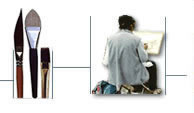Original Oil Paintings by South African Artist
History of Oil Painting
From the time of the Greeks the chemistry of art and the chemistry of medicine were closely related and the recipes used for both were frequently written in the same books. These recipes were kept throughout the early centuries of Christianity by monks until their broader use outside of the monasteries in the middle ages. The use of drying oils is recorded among these recipes, listing walnut oil, poppy oil, hempseed oil, castor oil, and linseed oil as varnishes to seal pictures and protect them from water. Adequately thickened, they became resinous in and of themselves and therefore worked as varnishes quite well. Later on, yellow pigments were added to the oil and it was spread over tin foil to mimic the look of gold leaf, but at less cost. And as early as the thirteenth century oil was used for painting details over tempera pictures.
The oldest Mediterranean civilization, Greek, Roman or Egyptian have extensively used painting techniques based on mixtures of encaustic (probably rich in bee wax), mineral pigments (iron, copper, manganese oxides) and tempera. Vegetabel oils, such as flax, walnut or poppyseed oil were known to ancient Egyptians, Greeks or Romans, but no precise indication of their use in painting may be found. Tempera is a fluid mixture of binder (organic medium), water and volatile additives (vegetal essential oils).
At the end of the roman empire and up to the Renaissance period (15th century), this ancient technique was lost and replaced by oil paint and/or tempera. In Italy and Greece, olive oil was used to prepare pigment mixtures but the drying time was excessively long and tedious in the case of figures. This drawback led a German monk, Theophilus , in the 12th century to warn against paint recipes including olive oil. It was reported that Aetius Amidenus , a medical writer in the 5th century, mentioned the use of a drying oil as a varnish on paintings. Similarly, it seems that perilla oil was used in Japan in painting after addition of lead in the 8th century.
According to Giorgio Vasari (1511-1574) the technique of oil painting, as used till now with few technical modifications, was invented or re-invented in Europe around 1410 by Jan van Eyck (1390 -1441). In fact, as said before, this Flemish painter was not the first to use oil paint, his real achievement was the development of a stable varnish based on a siccative oil (mainly linseed oil) as the binder of mineral pigments. It could be established that the Van Eyck secret was a mixture of piled glass, calcined bones and mineral pigments in linseed oil maintained a long time up to a viscous state at boiling temperature. Besides linseed oil, walnut oil and poppy-seed oil were also used while not so quick-drying. It is probable that painters have already observed that these oils led to accelerated drying time of canvas under the sun.
After Van Eyck, Antonello da Messina (1430-1479) introduced a new technical improvement. He added a lead oxide (litharge) in the pigment-oil mixtures to increase their siccative property. Later, Leonardo da Vinci (1452-1519) improved the preparation in cooking the oily mixtures at low temperature (boiling water) after the addition of 5 to 10% of bee wax, thus preventing a too dark color. While Giorgione (1477-1510), Titian (1488-1576) and Tintoreto (1518-1594) have slightly altered the original recipe, this technique was kept secretly in Italian ateliers nearly during three centuries, thus warranting their supremacy and radiance in whole Europe. From 1600 and during his 9 year stay in Italy, Rubens studied the Italian medium and made his own improvements. It is reported that Rubens used walnut oil warmed with lead oxide and some mastic dissolved in turpentine to grind mineral pigments.

